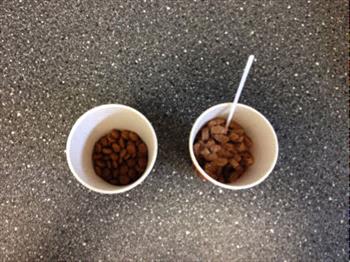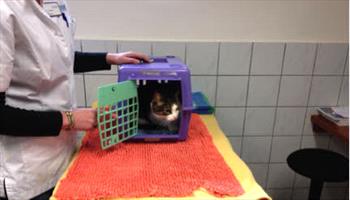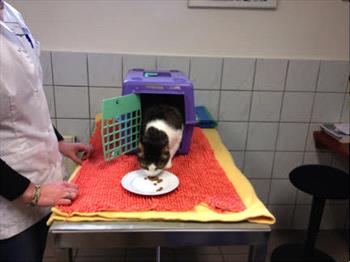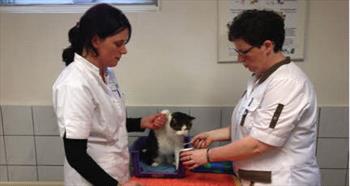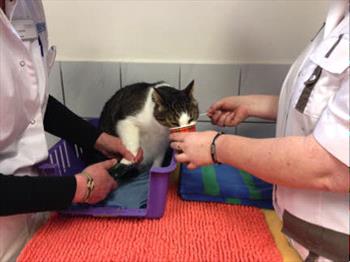Intro by Dr. Sophia Yin
In 2009, I produced the first and only textbook and DVD on Low Stress Handling of dogs and cats in the hospital or shelter setting. Since then the methods and philosophy have spread around the world. In this article, my colleague in the Netherlands, Dr. Valerie Jonckheer –Sheehy details how she used desensitization and counterconditioning to give a cat a pleasant toenail trim.
The techniques used in this case are based on Dr Sophia Yin’s protocol for trimming the nails of an anxious dog. Counterconditioning for Toenail Trim Aggression
15 April 2014
History:
The owner reports that this neutered male cat, Finn, is scared of vets and veterinary clinics because of previous bad experiences.
In the clinic:
We prepared for Finn’s arrival by putting blankets and towels on the examination table. We had a towel on standby should we need it for restraint. We prepared his dry cat food and canned food.
He was on a special diet so we could only use his own food. The owner told us that he prefers the wet food to dry food.
We noted that the cat seemed distressed on arrival so after he’d had some time to acclimatize in his cat carrier, we opened the door.
He was reluctant to come out, his pupils were dilated and he was breathing rapidly. As a matter of fact, his carrier was too small for him.
We placed his food on a small saucer in front of his open carrier and he came out to eat it.
We removed the top half of his cat carrier and he went back in there.
We could have taken the cat carrier completely away but we decided not to because he seemed more comfortable in there and we knew we’d be able to clip his nails (should he allow us ☺) even in the carrier.
I picked up his front paw to see how he’d react. He quickly pulled his paw away from me even though there was food close by!
We decided we’d desensitize and counter condition him to having his nails clips, in other words; we’d try to get him to allow us to clip his nails and enjoy it!
Step 1: Change the emotional state of the cat.
We left him alone for a few seconds and then offered him some canned food on a small plastic spatula to help get him into a positive emotional state.
He sniffed at it but didn’t eat it right away. After a moment or two he started to lick it and eat it.
Step 2: Get the cat used to having his forepaw handled.
Once Finn was taking food happily from the veterinary technician, I picked up his forepaw and handled it gently.
We were careful that Finn always had food whilst I was handling his paw lowering the risk that he may try to bite us. It seemed like he didn’t even know that I was handling his paw! We repeated this process a few times.
Step 3: Get the cat used to having his forepaw tapped with the nail clippers.
I tapped on his foot whilst the veterinary technician kept his attention on the food. At this stage she allowed the cat to eat directly out of the paper cup containing his vanned food as he was really enjoying his meal and we were getting to a crucial stage in the protocol!
He didn’t seem to notice. We made sure to pause for a short time between tapping sessions. When I wasn’t handling Finn’s paw, he didn’t get anything. That way he learned that paw handling equals treats and no handling equals no treats! We repeated this step several times.
Step 4: Get the cat used to having the nail clippers placed around his nail without clipping!
I carefully extruded a nail with one hand and placed the nail clippers around his nail whilst the veterinary technician continued to keep Finn focus on his goodies!
I might have split this into two steps if Finn had been more anxious and extruded the nails in a separate step to extruding the nail and placing the clippers around it. But Finn was doing so well that we just went ahead. The owner had said at the start that she’d like to observe the training until this point if the cat would allow us to go that far but that she didn’t want us to clip his nail as she was worried he might get stressed out or hurt us. We asked her if she was sure about this and she smiled at us and told us to go ahead and clip!
Step 5: Clip the cat’s nail!
I carefully extruded his nail again, placed the clippers around it and clipped his nail whilst the veterinary technician kept him busy with his food! He didn’t flinch.
Biography
Valerie Jonckheer-Sheehy is a behaviour veterinarian and the owner of Animalytics veterinary behavioural medicine and animal welfare consultancy (http://www.animalytics.nl; www.facebook.com/animalytics) in the Netherlands. She diagnoses and treats behaviour problems in companion animals at a private veterinary referral hospital V.S.C. de Wagenrenk (http://www.wagenrenk.com).
© Valerie Jonckheer-Sheehy 2014 (reprinted with permission).


